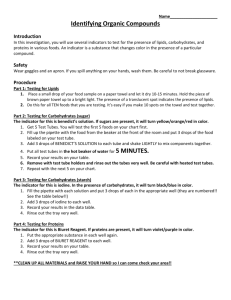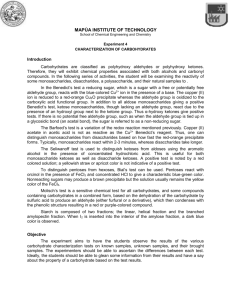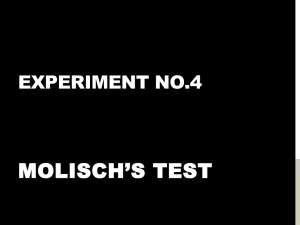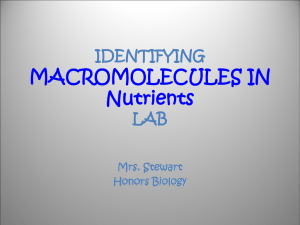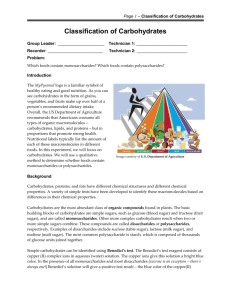Chemical Identification of Carbohydrates
advertisement
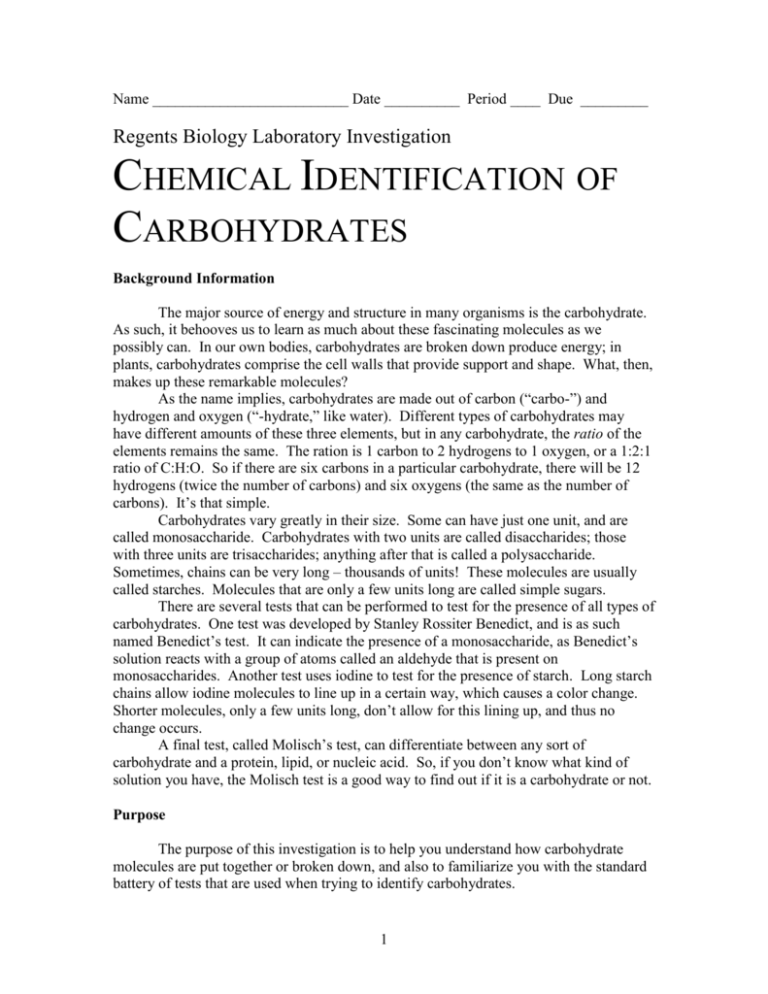
Name __________________________ Date __________ Period ____ Due _________ Regents Biology Laboratory Investigation CHEMICAL IDENTIFICATION OF CARBOHYDRATES Background Information The major source of energy and structure in many organisms is the carbohydrate. As such, it behooves us to learn as much about these fascinating molecules as we possibly can. In our own bodies, carbohydrates are broken down produce energy; in plants, carbohydrates comprise the cell walls that provide support and shape. What, then, makes up these remarkable molecules? As the name implies, carbohydrates are made out of carbon (“carbo-”) and hydrogen and oxygen (“-hydrate,” like water). Different types of carbohydrates may have different amounts of these three elements, but in any carbohydrate, the ratio of the elements remains the same. The ration is 1 carbon to 2 hydrogens to 1 oxygen, or a 1:2:1 ratio of C:H:O. So if there are six carbons in a particular carbohydrate, there will be 12 hydrogens (twice the number of carbons) and six oxygens (the same as the number of carbons). It’s that simple. Carbohydrates vary greatly in their size. Some can have just one unit, and are called monosaccharide. Carbohydrates with two units are called disaccharides; those with three units are trisaccharides; anything after that is called a polysaccharide. Sometimes, chains can be very long – thousands of units! These molecules are usually called starches. Molecules that are only a few units long are called simple sugars. There are several tests that can be performed to test for the presence of all types of carbohydrates. One test was developed by Stanley Rossiter Benedict, and is as such named Benedict’s test. It can indicate the presence of a monosaccharide, as Benedict’s solution reacts with a group of atoms called an aldehyde that is present on monosaccharides. Another test uses iodine to test for the presence of starch. Long starch chains allow iodine molecules to line up in a certain way, which causes a color change. Shorter molecules, only a few units long, don’t allow for this lining up, and thus no change occurs. A final test, called Molisch’s test, can differentiate between any sort of carbohydrate and a protein, lipid, or nucleic acid. So, if you don’t know what kind of solution you have, the Molisch test is a good way to find out if it is a carbohydrate or not. Purpose The purpose of this investigation is to help you understand how carbohydrate molecules are put together or broken down, and also to familiarize you with the standard battery of tests that are used when trying to identify carbohydrates. 1 Materials PENCIL Pipettes Benedict’s solution Lugol’s Iodine Hot plate Masking tape Scissors Pipette bulb Molisch’s solution Carbohydrate solutions Paper models Unknown solutions Test tubes Distilled water Sulfuric acid Test tubes Test tube rack Test tube holder Procedure SECTION I – MODEL CARBOHYDRATES In this section, you will use paper models to see how carbohydrates are put together. You will learn about dehydration synthesis and hydrolysis, and how different types of carbohydrates vary. There are three types of formulas with which you need to be familiar. The first type is called the structural formula. This shows a “picture” of the molecule, complete with the bonds that are holding the atoms together. A molecular formula tells you how many of each atom there are using subscripts, but doesn’t tell you how they are put together. The third type is the empirical formula. This formula’s subscripts represent only the ratio of the atoms present, not the actual numbers of them. We know that the empirical formula for any carbohydrate must always be C1H2O1. 1. Cut out the four carbohydrate units along the solid lines. Cut carefully, and don’t remove anything important! 2. You’re first going to make a disaccharide. Cut the dotted lines on the ends of two of the molecules so that they fit together like a lock and key. QUESTION 1: What atom(s) came off one of the carbohydrate units? QUESTION 2: What atom(s) came off the other carbohydrate unit? QUESTION 3: When you put all these atoms together, what do you get? QUESTION 4: Why does it make sense that this process of putting two carbohydrate units together is called dehydration synthesis? (hint: think about what each word means) 2 QUESTION 5: What was the molecular formula of each of the carbohydrate units before you put them together? QUESTION 6: What was the empirical formula of each of the carbohydrate units before you put them together? QUESTION 7: What is the molecular formula of the new disaccharide that you have created? (hint: you could just count the atoms…but think about what molecule you removed instead) QUESTION 8: What do the lines between the atoms in the structural formula shown in figure 1 represent? 3. Now make a trisaccharide. Attach another carbohydrate unit by cutting on the dotted lines so that it fits like a lock and key. QUESTION 9: What did you have to remove again to attach this carbohydrate unit? QUESTION 10: How many molecules of water have you removed to hook three carbohydrate units together? QUESTION 11: How many water molecules would you have to remove to hook together 1,000 carbohydrate units into a starch chain? SECTION II – TESTING OF CARBOHYDRATES In this section, you will be learning about the various tests that can be performed to determine what kind of carbohydrate you have, or, if you have a carbohydrate at all. It is absolutely necessary that you wear safety goggles. The Benedict’s solution is irritating, and the sulfuric acid that you will be using is very concentrated and WILL destroy your eyes, skin, and clothing almost immediately. 3 A – MOLISCH’S TEST 1. Prepare your hot water bath. Two tables can share one water bath. Remember, this is just a hot water bath, not a boiling water bath. Set your hotplate appropriately. 2. While your bath is heating, you will perform Molisch’s test. This will allow you to tell which solutions of A, B, and C are carbohydrates. Label three tubes A, B, and C. 3. Add 5 mL of solutions A, B, and C to the appropriate tubes. 4. Add 1 mL of Molisch’s solution to each tube. 5. CAREFULLY drop 2 mL of sulfuric acid slowly down the side of each tube. A positive result is the formation of a reddish or purplish ring where the acid meets the test solution. 6. CAREFULLY dump your tubes into the beaker labeled “Molisch Test Waste,” then rinse out your tubes completely. Do not leave any acid behind! 7. Record your results in table 1. Solution Molisch’s Test Result Conclusion A B C Table 1. Results of Molisch’s test. QUESTION 12: Which solutions were carbohydrates? QUESTION 13: For the solutions that were not carbohydrates, can you tell what they were? B – BENEDICT’S TEST 1. Now that your hot water bath is ready, you can perform Benedict’s test. 2. Label four clean tubes 1, 2, 3, and 4. Solution 4 is just distilled water, so it will act as your control. You should not see a color change in this tube, and you can use tube 4 as a comparison for tubes 1, 2, and 3. 3. Add 5 mL of solutions 1, 2, 3, and 4 to the appropriate tubes. 4. Add 5 mL of Benedict’s solution to each tube. 5. Place the tubes in the hot water bath for about 4 minutes. 6. Remove the tubes with a test tube holder (they will be hot!), and place them in your test tube rack. A color change to orange, yellow, brown, red, or green indicates the presence of a monosaccharide. If the blue color remains, a monosaccharide is not present. 4 7. Dump your tubes in the beaker labeled “Benedict’s Test Waste,” and rinse out your tubes completely. 8. Record your results in table 2. Solution Benedict’s Test Result Conclusion 1 2 3 4 (control) Table 2. Results of Benedict’s Test C – IODINE TEST 1. Label four clean test tubes 1, 2, 3, and 4. Solution 4 is just distilled water, so it will act as your control. You should not see a color change in this tube, and you can use tube 4 as a comparison for tubes 1, 2, and 3. 2. Add 5 mL of solutions 1, 2, 3, and 4 to the appropriate tubes. 3. Add 1 mL of iodine to each tube. 4. Observe the tubes. A color change to a deep black-purple indicates the presence of a polysaccharide. If the iodine remains orangey-brown, no polysaccharide is present. 5. Dump your tubes in the beaker labeled “Iodine Test Waste,” and rinse out your tubes completely. 6. Record your data in table 3 Solution Iodine Test Result 1 2 3 4 (control) Table 3. Iodine test results. 5 Conclusion Analysis QUESTION 14: In the space below, indicate what type of carbohydrate (mono-, di-, or polysaccharide) each solution was, and say HOW you came to that conclusion. QUESTION 15: What is the empirical formula of all carbohydrates? QUESTION 17: Betty is testing a solution in her laboratory. She performs Molisch’s test and gets a negative result. Can Betty tell what kind of solution she has? Can she tell what kind of solution she doesn’t have? Explain your answer completely. QUESTION 18: Wesley stole a bottle with no label from the supermarket’s carbohydrate aisle. He wants to know what kind of sugar he has, so he performed Benedict’s test and received a positive result. Can Wesley accurately say what type of carbohydrate he has purloined? Explain your answer completely. QUESTION 19: Janelle has a solution that gives a negative result for the iodine test. Explain what else she could do to determine exactly what kind of carbohydrate she has. QUESTION 20: List two things that you would change in this lab if you could. 6
